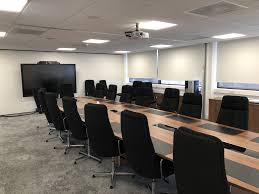The Ultimate Guide to Meeting Room Conference Systems
In today’s fast-paced business world, effective communication is key to success. Meeting room conference systems play a crucial role in facilitating seamless collaboration among team members, clients, and partners, regardless of their physical location.
Meeting room conference systems come in various shapes and sizes, offering a range of features to suit different needs. From basic audio conferencing setups to advanced video conferencing solutions with integrated screens and cameras, there is a system for every requirement.
Key Features of Meeting Room Conference Systems:
- Audio Quality: Clear and crisp audio is essential for productive meetings. Look for systems that offer noise cancellation and echo reduction for optimal sound clarity.
- Video Capabilities: Video conferencing allows participants to see each other in real-time, enhancing communication and fostering a sense of connection. HD video quality and smooth streaming are must-have features.
- Screen Sharing: The ability to share presentations, documents, and other visual aids during meetings is vital for collaboration. Ensure the system supports easy screen sharing across devices.
- Integration with Productivity Tools: Seamless integration with popular productivity tools such as Microsoft Outlook, Google Calendar, and Slack can streamline meeting scheduling and enhance efficiency.
- Remote Access: With the rise of remote work, the ability to join meetings from anywhere is essential. Look for systems that offer mobile compatibility and support for multiple devices.
Tips for Choosing the Right System:
When selecting a meeting room conference system for your organisation, consider factors such as the size of your meeting rooms, the number of participants typically involved in meetings, budget constraints, and future scalability needs. It’s also important to test the system’s compatibility with your existing IT infrastructure before making a decision.
In conclusion, investing in a high-quality meeting room conference system can significantly improve communication within your organisation and enhance collaboration among team members. By choosing the right system that meets your specific requirements, you can create a productive meeting environment that drives success.
Top 6 Advantages of a Meeting Room Conference System: Boosting Communication, Collaboration, and Productivity
- Enhances communication among team members
- Facilitates seamless collaboration with remote participants
- Improves productivity by enabling efficient meetings
- Provides a platform for sharing presentations and visual aids
- Reduces travel costs associated with in-person meetings
- Supports flexible working arrangements and remote work
Challenges of Meeting Room Conference Systems: Navigating Costs, Complexity, and Compatibility
- High initial cost of purchasing and installing a quality conference system
- Complexity in setting up and troubleshooting technical issues may require IT support
- Limited flexibility in accommodating last-minute changes or upgrades to the system
- Potential compatibility issues with different devices and operating systems
- Reliance on stable internet connectivity for seamless video conferencing
- Security concerns related to data privacy and potential risks of hacking during online meetings
- Learning curve for users unfamiliar with the features and functionality of the conference system
Enhances communication among team members
A key benefit of meeting room conference systems is their ability to enhance communication among team members. By providing a platform for seamless audio and video conferencing, these systems allow team members to connect in real-time, regardless of their physical location. This improved communication fosters collaboration, idea sharing, and decision-making, leading to increased productivity and efficiency within the team. With features such as screen sharing and remote access, meeting room conference systems facilitate clear and effective communication, ensuring that all team members are on the same page and working towards common goals.
Facilitates seamless collaboration with remote participants
One of the key advantages of a meeting room conference system is its ability to facilitate seamless collaboration with remote participants. By enabling individuals from different locations to join meetings virtually, these systems break down geographical barriers and allow for real-time communication and interaction. Remote participants can actively engage in discussions, share their perspectives, and contribute to the meeting just as if they were physically present, fostering a sense of inclusivity and teamwork across distances. This feature not only enhances productivity but also promotes a more diverse and inclusive work environment where all team members can participate and collaborate effectively.
Improves productivity by enabling efficient meetings
Meeting room conference systems offer a significant advantage by enhancing productivity through the facilitation of efficient meetings. By providing seamless communication channels and collaboration tools, these systems streamline the meeting process, enabling participants to engage more effectively and make decisions promptly. With features such as screen sharing, real-time document collaboration, and clear audio/video capabilities, meeting room conference systems ensure that discussions are focused, ideas are shared efficiently, and tasks are assigned promptly, ultimately leading to increased productivity within organisations.
Provides a platform for sharing presentations and visual aids
One significant advantage of meeting room conference systems is their ability to provide a platform for sharing presentations and visual aids. This feature enhances communication during meetings by allowing participants to display slides, documents, charts, and other visual content in real-time. By facilitating the seamless sharing of information, meeting room conference systems promote engagement, collaboration, and a more interactive meeting experience, ultimately leading to increased productivity and better decision-making outcomes.
Reduces travel costs associated with in-person meetings
One significant advantage of meeting room conference systems is their ability to reduce travel costs typically associated with in-person meetings. By enabling remote participants to join meetings virtually, organisations can eliminate the need for expensive travel arrangements, such as flights, accommodation, and transportation. This not only leads to substantial cost savings but also promotes environmental sustainability by reducing carbon emissions from business travel. Additionally, virtual meetings allow for greater flexibility in scheduling and participation, making it easier for team members from different locations to collaborate efficiently without the constraints of physical distance.
Supports flexible working arrangements and remote work
Meeting room conference systems offer the invaluable benefit of supporting flexible working arrangements and remote work. With the capability to connect employees from different locations in real-time, these systems enable seamless collaboration regardless of physical proximity. This feature not only promotes work-life balance but also enhances productivity by allowing team members to participate in meetings, discussions, and presentations remotely. By facilitating remote work, meeting room conference systems empower organisations to embrace modern working trends and adapt to changing business landscapes with ease.
High initial cost of purchasing and installing a quality conference system
One significant drawback of implementing a quality meeting room conference system is the high initial cost associated with purchasing and installing the equipment. The investment required for a top-notch conference system, including high-quality audiovisual devices, integrated software, and professional installation services, can be substantial. This upfront expense may pose a financial challenge for some organisations, especially small businesses or startups with limited budgets. The initial cost factor can deter companies from upgrading their meeting room technology or investing in advanced conferencing solutions, potentially hindering their ability to enhance communication and collaboration within the organisation.
Complexity in setting up and troubleshooting technical issues may require IT support
One significant drawback of meeting room conference systems is the complexity involved in setting up and troubleshooting technical issues, which often necessitates IT support. The intricacies of integrating various components, configuring settings, and addressing connectivity issues can pose challenges for users who may not have the technical expertise required. This reliance on IT support for setup and troubleshooting can lead to delays in starting meetings, disrupt workflow continuity, and potentially incur additional costs for organisations seeking quick resolutions to technical issues.
Limited flexibility in accommodating last-minute changes or upgrades to the system
One significant drawback of meeting room conference systems is their limited flexibility in accommodating last-minute changes or upgrades to the system. Once a system is installed and configured, making sudden adjustments or integrating new features can be challenging and time-consuming. This lack of agility can hinder the adaptability of the system to evolving business needs, potentially causing disruptions in meeting schedules and productivity. Organizations may find themselves constrained by the system’s rigid structure, making it difficult to keep up with technological advancements or changing requirements without significant effort and cost.
Potential compatibility issues with different devices and operating systems
One significant drawback of meeting room conference systems is the potential compatibility issues that may arise when trying to connect and integrate various devices and operating systems. Different devices, such as laptops, tablets, and smartphones, running on diverse operating systems like Windows, macOS, iOS, and Android, can sometimes struggle to communicate effectively with the conference system. This can lead to connectivity issues, software conflicts, and hindered functionality during crucial meetings, causing delays and frustration among participants. It is essential for organisations to address these compatibility challenges proactively by ensuring thorough testing and troubleshooting to minimise disruptions and ensure smooth communication flow in meetings.
Reliance on stable internet connectivity for seamless video conferencing
A significant drawback of meeting room conference systems is their reliance on stable internet connectivity for seamless video conferencing. In today’s digital age, a stable internet connection is crucial for conducting productive virtual meetings. However, fluctuations or interruptions in internet service can lead to disruptions during video conferences, causing delays, audio/video lag, or even complete disconnections. This reliance on external factors beyond the system’s control can hinder the smooth flow of communication and collaboration, highlighting the vulnerability of meeting room conference systems to technical issues related to internet stability.
Security concerns related to data privacy and potential risks of hacking during online meetings
Security concerns related to data privacy and potential risks of hacking during online meetings are significant cons of meeting room conference systems. With the increasing reliance on digital communication, the protection of sensitive information shared during virtual meetings becomes paramount. Hackers may exploit vulnerabilities in the system to intercept confidential data or disrupt meetings, posing a threat to organisational privacy and integrity. Ensuring robust encryption protocols, implementing multi-factor authentication, and regularly updating security measures are essential steps to mitigate these risks and safeguard the confidentiality of online discussions.
Learning curve for users unfamiliar with the features and functionality of the conference system
One notable drawback of meeting room conference systems is the learning curve faced by users who are unfamiliar with the features and functionality of the system. Navigating through various settings, understanding how to initiate calls, share screens, or adjust audio and video settings can be overwhelming for new users. This challenge may lead to delays in starting meetings, technical hiccups during conferences, and overall frustration among participants. Providing comprehensive training sessions and user-friendly guides can help mitigate this issue, ensuring smoother adoption and efficient use of the conference system.



